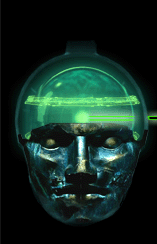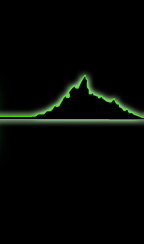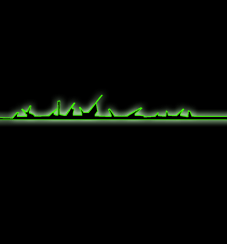We often see films of dystopias demonstate the extreme segregation of the realms above and below ground. Fritz Lang and Osamu Tezuka’s respective versions of Metropolis and The Matrix Trilogy, above, all demonstrate a sort of mechanized underground, complete with immense gears, fly-wheels and cogs, quite literrally driving the city above. Of course, this sub-terranean realm of the city relates to the creation of the ‘utopia’ above, intrinsically linking the two parts, as the ‘dark and light’ opposing elements of the city, while defining an absolute social segregation.
Osamu Tezuka’s Metropolis
The models of Dark City clearly shows its overall structure, sprialling from its centre of control and upward from its dark, psycho-mechanical controlling system below. This model is strkingly similar to the (albeit more organically represented) interconnected, hierarchical network of the City of Olympus, in Appleseed.
The gearing, and mechanical systems find themselves further emphasized as literal clockwork in Dark City, where the alien controllers of the city above use the massive underground mechanical system to manipulate the actual form and configuration of the city.
This mechanized city, interestingly has its roots in Lang’s Metropolis, but in the original film’s case, it is the poor, enslaved working class that inhabits and operates the machines beneath the city, to support the opulence of those living above.
A similar model of ‘mechanized city’ is demonstrated in Terry Gilliam’s Brazil, indicated by the piping and ductwork that snakes its way through the entire city, from deep underground, upward. This makes it at many instances in the film, impossible to determine whether one is actually above ground, forty stories below.
The imagery of piping, conduit and technology has become a common approach to the stylization of the environments of dystopic science fiction films. The Nostromo, a veritable city in space from the film Alien, seems to be entriely constructed of narrow, claustrophobic tunnels, lined with piping and panelling, to a degree of complexity that renders the image of technology as something organic, and with a life of its own.
A similar appearance is found in The Matrix trilogy, again in the underground city, of Zion, where the inhabitants must face their ironic dependency on machines to live in these sub-terranean conditions, while continuing to battle the machines living above, who, themselves are using human beings, in turn, as a form of energy for their own survival.
The construction of the futuristic vision of Los Angeles in Blade Runner shows further vertical stratification, as the new, future city emerges from the old urban setting. With these great structures rising above beyond view, the ground has become a place of darkness, filled with the gritty urban life of a depressed future earth.
The animated films, Akira and Osamu Tezuka’s Metropolis, both feature similar nests of intertwining pipes, somehow resembling the cores of the mechanized cities below ground, from which the respective figures of great transformation, power and rebellious energy emerge. Though rooted in technological imagery, these dark cores of the cities below poetically create the figures who bring destruction to their controlling cities above.



Often along side the mechanized underbelly of the dystopic future city, lies the more organic, seemingly natural caverns and catacombs, from which an uprising against the oprressive forces above will begin. Zone 1 of Osamu Tezuka’s Metropolis, the carnival-like, organically organized architecture below the ground is surely based upon the catacombs of the original Metropolis, in which Maria preaches to the workers, and speaks of a coming mediator between the ‘Head and Hands’ of the city. A nearly direct translation of this environment and story is found in the images of Morpheus speaking before the people of Zion in The Matrix Reloaded. Again, the prophecy he follows tells of a savior (Neo) who will free the city, and ultimately bring about a truce between humans and machines of the film. This organic setting, however, seems important as a place where the notion of ‘peace’ is delivered, remaining in our psyche as some utlimate place of truth, justice, and nature, at the core of the earth.






Dark City
HOME UW School of Architecture – Jonah Humphrey
















































